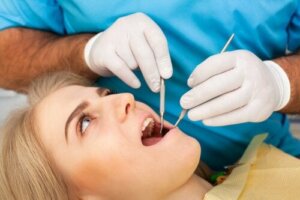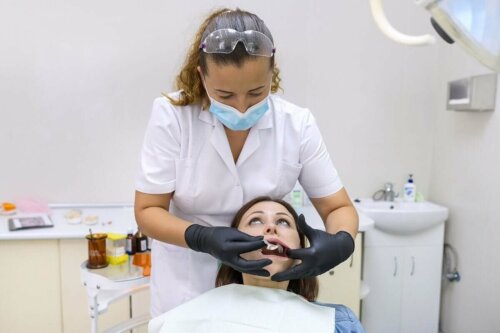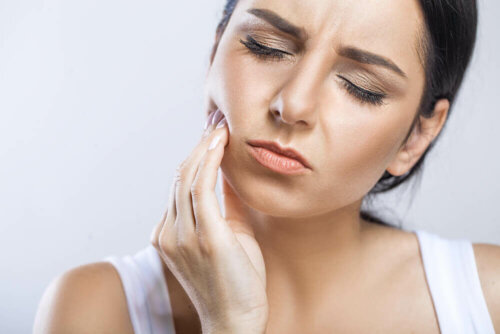8 Ways to Care for Your Mouth After a Tooth Extraction


Written and verified by the dentist Vanesa Evangelina Buffa
Surgical procedures that require a dentist to extract a tooth from the bone where it sits come with certain advice. Proper care after a tooth extraction is needed for the treated area to heal and recover.
A specialist will administer the surgical intervention to a patient under local anesthetic so they don’t feel any pain. In more pressing cases, it may be necessary for the patient to be asleep. In this case, the dentist is likely to use a general anesthetic. The professional will first remove the tooth from the gingival tissue that supports it.
Next, with hoists and clamps, the dentist will loosen the tooth and remove it from the socket it sits in. More complex cases may require other apparatus to cut the gums, or remove the bone or cut the tooth into smaller fragments.
When the tooth is out of the mouth, the space it leaves behind usually forms a blood clot. This is responsible for healing the wound. Caring for and preserving it is vital to ensure it heals correctly.
In this article, we tell you why it’s necessary to care for your mouth after a tooth extraction, and how you can do it.
When is it necessary to extract a tooth?
Tooth extraction is a fairly common surgical intervention in adults. Although the dentist will try to save as many teeth in the mouth as possible, there are cases where extracting a tooth is unavoidable. Below, we go into more detail:
- Dental infection: when antibiotics just don’t cut it, the infection comes back, it can’t be treated with endodontics, or it expands to other areas of the body.
- Risk of infection: patients with a compromised immune system or with a tooth that could lead to a health risk.
- Cavities: when the illness is very advanced and the tooth has been almost destroyed. There are cases that neither arrangements nor inlays can solve.
- Dental fracture or trauma damage: injuries to the teeth as a result of a hit may mean that the tooth or its fragments need to be extracted.
- Advanced periodontitis: the loss of tissues that support the teeth can cause them to move, and so they may need to be extracted.
- Overcrowding: cases where the teeth are overlapping and stacked on top of each other. Here, orthodontic intervention will complement the tooth extraction.
- For orthodontic reasons: as part of the orthodontic treatment, it may be necessary for some teeth to be removed to create space.
- Problems with wisdom teeth: when these teeth don’t have space to come through, they can cause pain, and infections or generate other problems for the mouth, it may be necessary to extract them.

8 ways to care for your mouth after a tooth extraction
After a tooth extraction, post-operation care is important for the healing process, in hopes it’s as pleasant as possible for the patient. Generally, the mouth takes between 7 and 10 days to heal a wound, according to the type and location of the surgery.
During the first 3 days, you may experience some pain, swelling, and bruising. Looking after the blood clot that forms in the space where the tooth was is key for ensuring it heals correctly.
Following your dentist’s advice is important to avoid any complications and to have a successful healing process. But, what do you have to bear in mind? Take a look at the following tips:
1. Apply pressure with gauze
After your surgery, the dentist will apply a folded piece of gauze and will then ask you to bite down. This pressure will last for the first 30 to 60 minutes (the professional will determine the exact time according to your specific case).
The gauze’s job is to stop the bleeding and help the blood clot to form. As we already mentioned, the blood clot that forms in the space the tooth left is necessary to close the wound.
You shouldn’t leave the gauze on for too long as the clot could form to it. If that does happen, when you go to remove it, the clot will come away too, leaving the wound open, which can complicate the healing process.
After the time that your dentist has recommended has passed, you can remove the gauze. You won’t need to wear it anymore. If the bleeding is excessive and doesn’t stop after a couple of hours, you can replace the gauze and put pressure on it. But, you should also consult a professional.
2. Apply a cold compress to the area after a tooth extraction
Cold compresses can help to reduce inflammation, prevent bruising, and calm pain. For that reason applying a cold compress with ice to your face close to the affected area can really help.
You should apply the compress immediately after surgery for intervals of no more than 10 minutes. After those 10 minutes, rest for the same amount of time and then you can start the process again. Leaving ice on the skin for a long time can damage the tissues.
Also, it’s important to avoid proximity to heat like that from a stove, the heating in your home, or kitchens in general. It’s also not a good idea to sunbathe or leave the house if it’s too hot outside.
3. Eat soft and cold foods
After a tooth extraction, we advise you avoid eating hot food. To help with the healing process and reduce strain on the affected area, it’s best to eat soft, ground-up foods that are easy to chew.
Soft and cold foods like shakes, ice creams, yogurts, cold soups and pudding are ideal. You should avoid hard, crunchy foods or those with small seeds.
A balanced diet that contains pasta, eggs, fish, milk, and cooked vegetables will provide the necessary nutrients. All of these also have an ideal consistency. The zinc present in green vegetables and the vitamin C in citrus fruits can also help with the healing process.
It’s important to avoid consuming these foods with straws. Instead, we recommend you use spoons and take gentle sips. You can include harder foods in your diet gradually, but we recommend you continue with this tip for a week or so.
4. Rest and don’t exercise after a tooth extraction
Limiting your physical activity and efforts after a tooth extraction can help to avoid complications after surgery. It’s a good idea not to talk or move your mouth too much.
Resting with your head elevated in a more seated position is vital. Horizontal positions favor pain and bleeding from an accumulation of blood. Use a couple of pillows and cushions in your bed to help you with this when you sleep.
5. Take the medication your dentist advises
After a tooth extraction, and when the anesthesia wears off, you may experience some symptoms like pain and inflammation. For that reason, the dentist will usually prescribe you some anti-inflammatory medication in the hope to reduce these annoyances.
If you had your tooth removed because of an underlying infection, it’s likely that you’re already taking antibiotics. If that’s not the case, the dentist will prescribe them to you after the extraction. You should take these at the indicated times – without skipping doses – until you have completed the treatment as prescribed.
However, you should also tell your dentist if you’re taking other kinds of medication. This is to determine whether suspension or replacement is necessary before the surgery.

6. Don’t suck or rinse your mouth
Stopping the blood clot from shedding is vital for the healing process. If it comes loose, you run the risk of suffering an infection or alveolitis.
For that reason, it’s a good idea to avoid mouthwashes, gargling, swishing, or spitting forcefully. Similarly, you should limit any sucking action since that can increase the risk of the blood clot coming loose.
7. Don’t smoke
Smoking a cigarette after a tooth extraction is harmful and counterproductive. As we mention above, sucking action can cause the blood clot to come loose.
The heat promotes bleed and can lead to a risk of hemorrhaging. And, as if that wasn’t enough, tobacco use can lead to infection by altering the circulation in an area, and the toxins it contains.
8. Keep your mouth clean
It’s essential to keep your mouth clean after a tooth extraction to avoid infections. You should continue using your toothbrush and dental floss regularly, with gentle movements but avoiding the area where the tooth where was removed.
Cleaning your tongue helps to reduce bad smells and tastes that the healing process may cause. It’s important to ensure that you don’t allow bits of food to build up in the wound.
After a few days, you can start using gentle mouthwashes with warm water and salt, or ones without alcohol. It’s a good idea not to spit them out; you should let them fall on their own.
You may also be interested in: All About Tongue Cleaners: What They Are and How to Use Them
Why is it important to care for your mouth after a tooth extraction?
Ensuring you follow a care plan after a tooth extraction is essential to avoid complications. The wound may take between 7 to 10 days to heal. After this, your body will grow a new bone to fill the space the tooth left.
As such, following a professional’s advice will help to reduce post-operational risks. Among those, we can find the following:
- Hemmoraghing: this is when the wound continues to bleed excessively without stopping after several hours after the extraction.
- Infection: the extraction zone may smell bad, hurt, pulse, swell or fester. Your face and neck may also swell, be hot, or painful.
- Dry socket: due to the blood clot leaking, the area where the tooth was may be left empty, leaving the bone exposed. This is a very painful condition. The dentist may induce new bleeding and may fit a dressing to start another healing process.

When should you visit a dentist after a tooth extraction?
Despite you following all the care guidelines after a tooth extraction, you may experience some of the complications we mentioned above. If that is the case, you should visit a dentist or nearby hospital, urgently.
You should also consult a health professional if you present any of the following symptoms:
- Pain or discomfort that doesn’t heal after 2 to 3 days after the extraction.
- Annoyances or pain that spread to other parts of the body (ear, head, or neck).
- Swelling or inflammation in the face or neck.
- Pus in your mouth or the wound.
- Excessive bleeding that doesn’t stop after you bite on some gauze.
- High fever with general unease, nausea, or vomiting.
- Pins and needles, cramps, or if you feel like the area has “fallen asleep” after the anesthesia has worn off.
- Feeling pressure under your tongue.
- Difficulty breathing, swallowing, or talking.
- Coughing and pain in your chest.
If everything is fine after the extraction it’s also a good idea to go back to the dentist to control the healing and talk about the possibilities of replacing the lost tooth. The professional will be able to better assess the alternatives to rehabilitate the mouth to recuperate the function and aesthetic.
Getting your smile back
Needing a tooth extracted can cause fear and anxiety because it’s a surgical procedure that comes with its own risks and complications. Additionally, losing a tooth may lead a person to want to replace it.
For that reason, after the extraction, you should talk to your dentist about the possibility of replacing the tooth with a denture, fixed bridge, or implant. Also, it’s vital to follow the care guidelines after an extraction to ensure that the healing process is the healthiest possible.
All cited sources were thoroughly reviewed by our team to ensure their quality, reliability, currency, and validity. The bibliography of this article was considered reliable and of academic or scientific accuracy.
- Samuel, Ladisleny Leyva, Nila Ledesma Céspedes, and Myrna Fonte Villalón. “La pérdida dentaria. Sus causas y consecuencias.” Revista de Medicina Isla de la Juventud 19.2 (2018).
- Perez, Víctor Jesús Delgado, et al. “Principales razones de extracción de dientes permanentes de adultos mexicanos en un Centro de Salud.” Revista CES Salud Pública 8.1 (2017): 1-9.
- Rosero Ortiz, José Andrés. Causas para extracciones dentales e indicadores sociodemográficos realizado en la Clínica de Cirugía I de la Facultad de Odontología de la Universidad Central del Ecuador. BS thesis. Quito: UCE, 2018.
- Coronel Salazar, Angie Mishel. Complicaciones mediatas e inmediatas en las extracciones dentarias. BS thesis. Universidad de Guayaquil. Facultad Piloto de Odontología, 2020.
- Lozada Macías, Cristina Anabel. Complicaciones de extracciones de las piezas# 16 o# 26. BS thesis. Universidad de Guayaquil. Facultad Piloto de Odontología, 2018.
- Vélez Lucas, Nathalia Elizabeth. Efectividad del manejo terapéutico preventivo de la alveolitis, pre y post exodoncia, en pacientes con enfermedades sistémicas. BS thesis. Universidad de Guayaquil. Facultad Piloto de Odontología, 2020.
- Caliskan, Mehmet, et al. “¿ Es necesario modificar la terapia anticoagulante en extracciones dentales en pacientes que están en tratamiento con anticoagulantes orales de acción directa?.” Medicina oral, patología oral y cirugía bucal. Ed. española 23.4 (2018): 260-266.
- Teixeira Poças, María Amelia, et al. “Complicaciones posoperatorias de la exodoncia 2018-2019.” IV Jornadas de Actualización en Prácticas Odontológicas Integradas PPS-SEPOI (La Plata, 7 de julio de 2020). 2020.
- Vega Vega, Sheila P., et al. “Riesgo de complicaciones a corto plazo asociadas con extracción dental en pacientes de una unidad de medicina familiar de Acapulco, Guerrero, México.” Atención Familiar 25.4 (2018): 151-154.
This text is provided for informational purposes only and does not replace consultation with a professional. If in doubt, consult your specialist.








